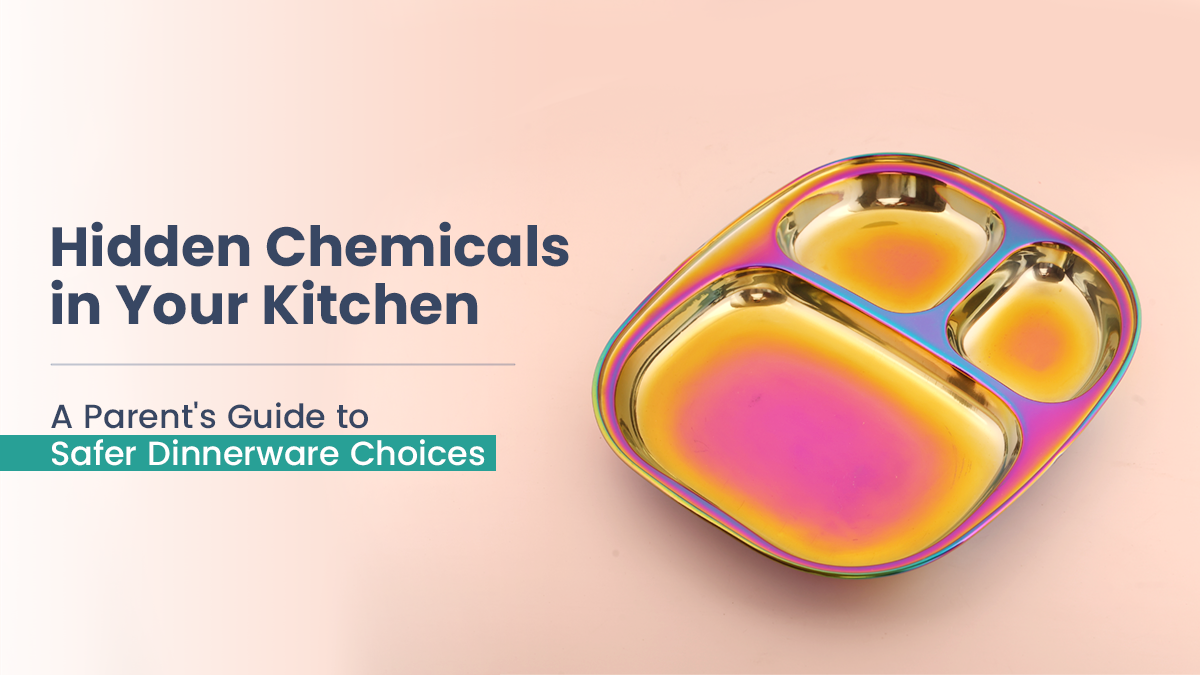As parents, we spend so much time planning healthy meals, cutting sugar, adding greens, and balancing nutrients. But what if the hidden danger isn’t in the food itself, but in the plates and glasses we serve it on? Plastics can release toxins, while painted ceramics may hide heavy metals.
Unsafe dinnerware can undo all your efforts to keep your child healthy. That’s why knowing what’s safe and what isn’t is one of the smartest steps you can take for your family’s health.
This blog can be your guide to recognizing risks and making safer choices with chemical-free kids' dinnerware and non-toxic kids' tableware that you can trust. Let’s get it started.
Chemical leaching from common materials
Many families still rely on plastic, melamine, or cheap ceramic dishes. While affordable, these often come with hidden risks.
Common culprits include:
-
Plastic Dinnerware: Contains BPA, phthalates, and other endocrine disruptors that can interfere with hormonal development in children. When heated, these chemicals leech into their food.
-
Melamine Tableware: Often marketed as "break-resistant" for kids, melamine releases formaldehyde and melamine compounds when exposed to heat or acidic foods like tomatoes or citrus.
-
Low-Grade Ceramics: May contain lead in glazes, particularly in brightly colored or imported pieces without proper safety certifications.
-
Aluminum Cookware: Can leach aluminum into acidic foods, potentially affecting neurological development in growing children.
Children, with their developing bodies and faster metabolisms, are especially vulnerable to these. Even small exposures over time can have long-term effects. Choosing chemical-free kids' dinnerware made from stainless steel or certified-safe materials is a healthier, safer alternative.
How to identify unsafe dinnerware
Protecting your family starts with knowing what to avoid. Here are warning signs of potentially toxic dinnerware materials:
Visual Signs:
-
Faded, cracked, or scratched surfaces on utensils indicate chemical breakdown.
-
Cloudy or discolored plastic items mean it is worn out.
-
Peeling or chipped paint or glazes is a big danger.
-
Strong chemical odors when new mean the quality is cheap.
-
Bright, glossy finishes on low-quality ceramics (may indicate lead or cadmium).
Material Red Flags:
-
Any plastic marked with recycling codes 3, 6, or 7 shouldn’t be reused more than once.
-
Melamine dinnerware with no labeling or safety guarantees.
-
Ceramics without lead-free certifications
-
Imported dinnerware without safety documentation
Behavioral Signs:
-
Items that become hot in the microwave (indicating absorption)
-
Plates that retain food odors or stains portray poor quality.
-
Dinnerware that shows wear after minimal use
Remember: if it looks suspicious, smells off, or lacks proper labeling, it doesn't belong near your child's food.
When in doubt, avoid products that don’t specify they are safe for food contact. Safe dinnerware should never leave you guessing.
Reading safety certifications
One of the easiest ways to ensure safe children’s plates in India is to check for dinnerware safety certifications. These labels are proof that the product has been tested for safe, everyday use:
-
US FDA Approved: Indicates the material meets American food safety standards for direct food contact.
-
BPA-Free Certification: Specifically confirms the absence of Bisphenol A, a known endocrine disruptor.
-
Lead-Free Testing: Essential for ceramic and glass items, ensuring no lead content in glazes or materials.
-
CPSIA Compliance: Children's Product Safety Improvement Act certification for products specifically designed for children.
-
Food Grade Stainless Steel: Look for 304 or 316 grade stainless steel, which meets international food safety standards.
-
Third-Party Lab Testing: Independent verification of safety claims provides additional assurance beyond manufacturer declarations.
When shopping for chemical-free kids' dinnerware, always request documentation of these certifications. Reputable manufacturers will readily provide safety test results and certification details.
Protecting children from toxic exposure
Children’s growing bodies absorb toxins more quickly than adults, which makes safe dinnerware a necessity, not a luxury.
Beyond choosing safer materials, implement these protective measures:
-
Temperature Awareness: Never microwave plastic or melamine items. Heat dramatically increases chemical leaching rates.
-
Proper Maintenance: Replace cracked, scratched, or worn dinnerware immediately. Damaged surfaces release more chemicals.
-
Food Pairing: Avoid serving acidic foods (tomatoes, citrus, vinegar-based dishes) in questionable materials.
-
Gradual Transition: Replace unsafe items systematically, starting with frequently used pieces and items exposed to heat.
Using non-toxic kids' tableware reduces exposure to harmful chemicals, supports healthy growth, and teaches children to value safe eating habits from an early age.
As a parent, knowing that your child’s food is served in dishes designed with children’s dinnerware safety in mind brings peace of mind every single day.
Making informed purchasing decisions
Switching to safer options doesn’t have to be overwhelming. Here’s a quick checklist for parents:
-
Opt for chemical-free kids' dinnerware.
-
Stay away from toxic dinnerware materials like low-grade plastic or untested ceramics.
-
Always look for dinnerware safety certifications.
-
Prioritize non-toxic kids' tableware that balances safety, durability, and style.
-
Research Before You Buy: Read reviews from other parents
-
Choose established brands with transparent manufacturing processes.
-
Consider long-term value over initial cost.
By choosing wisely, you’re investing in your child’s health and your family’s future.
The Bottom Line
The hidden chemicals in common dinnerware pose real risks to your child's developing body. While the initial cost of safer alternatives might seem higher, consider the long-term benefits: reduced toxic exposure, durability that saves money over time, and peace of mind that's truly priceless.
Making the switch to chemical-free kids' dinnerware isn't just about avoiding immediate harm – it's about setting the foundation for your child's lifelong health. Every meal served on safe, non-toxic tableware is an investment in their future.
Your children depend on you to make these crucial safety decisions. Armed with this knowledge, you can transform your kitchen into a truly safe space where healthy food meets healthy dinnerware – exactly what your family deserves.
Start today: examine your current dinnerware, research safer alternatives, and take the first step toward a chemical-free kitchen. Your children's health will thank you for it.


